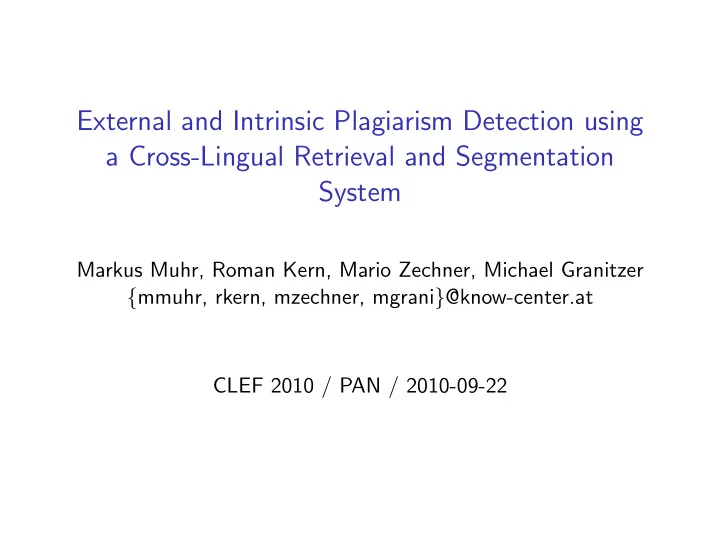

External and Intrinsic Plagiarism Detection using a Cross-Lingual Retrieval and Segmentation System Markus Muhr, Roman Kern, Mario Zechner, Michael Granitzer { mmuhr, rkern, mzechner, mgrani } @know-center.at CLEF 2010 / PAN / 2010-09-22
Overview Graz University of Technology Hybrid System ◮ External ◮ Based on information retrieval techniques ◮ Post-processing based on sequence analysis ◮ Intrinsic ◮ Detect style change ◮ Cross-lingual plagiarism detection ◮ No heuristics for high obfuscation ◮ No word reordering ◮ No synonym resolution Focus ◮ Simulate a production system ◮ Scalable architecture 2 / 14
System Overview Graz University of Technology Flowchart Suspicious Source Document Documents For each source document External Intrinsic No Segment into small Token based sequence Segment document English? Translate Words overlapping blocks matching into coherent segments Yes Use block terms as Merge neighboring Filtering on stylometric queries & apply heuristics sequences features for fast retrieval Segment into overlapping blocks Search block index Blocks Yes Similarity & heuristics Add blocks to index found? filtering No If no external passages are detected Block Index Detected passages 3 / 14
External Plagiarism Detection Graz University of Technology Overview ◮ Two step approach ◮ Search for potentially matching suspicious document blocks ◮ Apply heuristic post-processing on the potential matches Work-Flow ◮ Build index out of source documents ◮ Build overlapping blocks (40 terms) ◮ Split suspicious documents into blocks (16 terms) ◮ Transform blocks into queries ◮ Search source index for matching source blocks 4 / 14
External Plagiarism Detection Graz University of Technology Query Construction ◮ For each block in the suspicious document build a query ◮ Sort query terms by document frequency ◮ Join the low frequent terms by AND ◮ Join the remaining terms by OR ◮ Additional heuristics to keep number of queries low 5 / 14
External Plagiarism Detection Graz University of Technology Post-Processing ◮ Starting with query-block pairs ◮ Expand the text around the query and the block ◮ Build token by token matrix ◮ Match for 3 consecutive tokens (and at least 10 characters) - other thresholds for translated documents ◮ Process the sequences ◮ Merged by a neighborhood criterion ◮ Finally a similarity between merged sequences is calculated 6 / 14
Cross-lingual Plagiarism Detection Graz University of Technology Overview ◮ Approach: Normalize all documents to English ◮ Multiple alternative translations ◮ Not the single-best translation, but multiple candidates ◮ Word translations ◮ First step of a complete statistical machine translation system 7 / 14
Cross-lingual Plagiarism Detection Graz University of Technology Word translations ◮ Sentence aligned multi-lingual corpus ◮ Europarl v5 Koehn [2005] ◮ Apply word alignment algorithm ◮ BerkeleyAligner Liang et al. [2006] ◮ Number of translation candidates sorted by probability ◮ Replace each non-English word by up to 5 translation candidates task time no translation 7 ms translation 9.38 ms 8 / 14
Intrinsic Plagiarism Detection Graz University of Technology Overview ◮ Style change detection ◮ Focus on features without semantics Work-Flow ◮ Identify regions within a document ◮ Build feature centroid vector ◮ Compare regions with centroid 9 / 14
Intrinsic Plagiarism Detection Graz University of Technology Region Detection ◮ First idea: Split document in blocks of equal size ◮ Approach: Linear text-segmentation algorithm ◮ Build blocks of coherent topics ◮ Stop-word filtered stems as features ◮ TextSegFault Kern and Granitzer [2009] ◮ Efficient O ( n ) ◮ Open-source 10 / 14
Result Graz University of Technology Candidate Retrieval Step ◮ How many false positives are retrieved by the block candidate selection? ◮ Left: Based on 500 suspicious document in the development corpus ◮ Right: Based on the evaluation corpus task hit all ratio task hit all ratio high 2543 3676 0.6918 high 13348 14756 0.9046 low 6614 6988 0.9465 low 14832 14883 0.9966 none 9381 9592 none 16784 16784 0.9780 1.0 translated 2349 2543 0.9237 translated 5462 6314 0.8651 11 / 14
Result Graz University of Technology Overall System Performance ◮ Performance results of detected plagiarism separated by different sub-tasks for the hybrid evaluation corpus task Precision Recall Granularity Score non-translated all 0.9299 0.8967 1.0553 0.8785 non-translated none - 0.9497 1.0025 - non-translated low - 0.9207 1.0968 - non-translated high - 0.8122 1.0771 - translated 0.8036 0.61616 2.1655 0.4195 external 0.9053 0.8631 1.1611 0.7949 intrinsic 0.212 0.1566 1.0 0.1802 Overall 0.8417 0.7057 1.1508 0.6948 12 / 14
Conclusions Graz University of Technology ◮ Hybrid system ◮ External plagiarism detection ◮ Support for cross-lingual plagiarism detection ◮ Intrinsic (style-based) plagiarism detection ◮ Issues ◮ Scalable (but slow implementation) ◮ Outlook ◮ We plan to build a web service initialized with the Wikipedia as source 13 / 14
The End Graz University of Technology Thank you! 14 / 14
References R. Kern and M. Granitzer. Efficient linear text segmentation based on information retrieval techniques. In MEDES ’09 , pages 167–171. ACM, 2009. ISBN 978-1-60558-829-2. P. Koehn. Europarl: A parallel corpus for statistical machine translation. MT summit , 5:12–16, 2005. P. Liang, B. Taskar, and D. Klein. Alignment by agreement. In Proceedings of the Human Language Technology Conference of the NAACL , pages 104–111, June 2006.
Recommend
More recommend